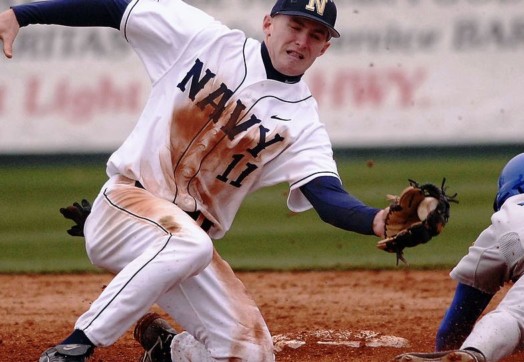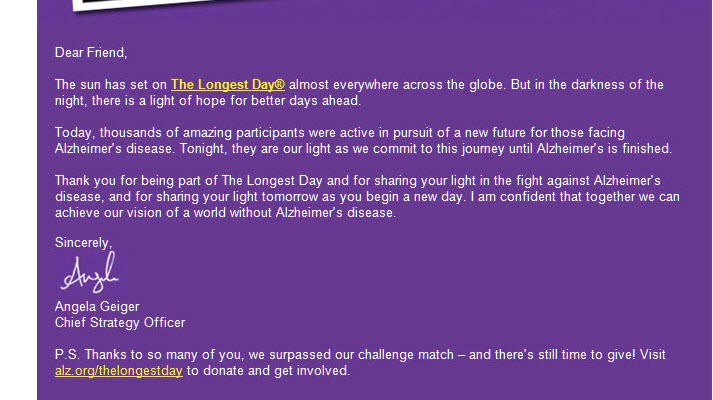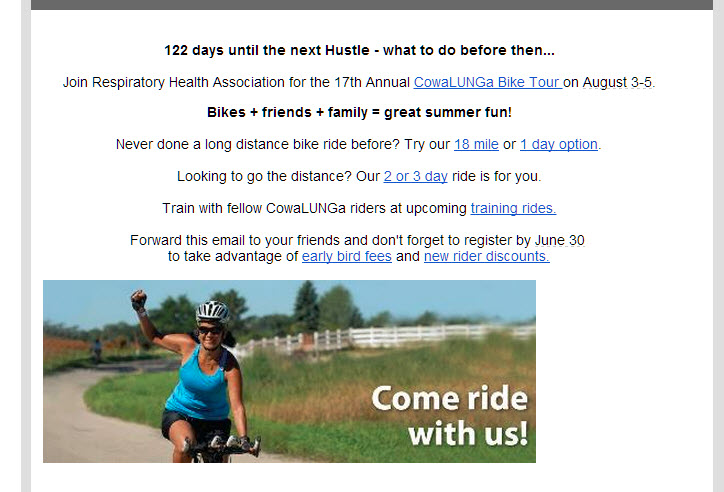4 Ways to Boost Retention Using Post-event Communications

It ain’t over till it’s over
With apologies to Yogi Berra for the mangled quote, in the world of peer-to-peer fundraising, an event ain’t over, even when it’s over. Ideally, work on this year’s event transitions seamlessly into the effort to establish NEXT year’s event success.
Are you ramping up for late summer or fall events? Be thinking about communicating to ensure retention while you’re planning how you’ll give event participants the best ever experience. Check your communication plan to be sure it contains messages aimed at maintaining your relationship with peer-to-peer fundraisers and volunteers AFTER the event’s over. Don’t have a communication plan? Then add these messages to your calendar!
I Don’t Have TIME to Do This Work!
True. It’s a busy time.
But consider this: Returning participants raise more money. In fact, they may outperform new participants by over 6x according to Blackbaud’s 2012 Peer-to-Peer Fundraising Benchmark Study. Success in retaining good participants will make your job easier next year; this effort now will help ensure continued growth of your event fundraising program year-over-year.

Retention of this year’s peer-to-peer fundraisers begins the day of the event. Use these key communication pieces to help solidify the relationship you made with supporters during this event season, and get a head start on recruitment of valuable returning event participants for next year:
1. Craft your big THANK YOU message in advance to be sent the day of the event.
- Celebrate the heartwarming moments of the event, its fundraising success and thank participants and volunteers profusely
- Queue up an email in advance. It doesn’t have to include specific fundraising totals – see the example below from Alzheimer’s Association
- Post similar “thank you” and “great job” messages to Facebook and Twitter. Add pictures from the event.
- The Alzheimer’s Association also makes great use of its Facebook page for The Longest Day event by sharing the personal stories and thanking participants.
- Robyn Mendez lays out easy-to-follow prompts for an event day Twitter strategy – in her post “40 Twitter-iffic Event Day Ideas”.

2. Announce fundraising totals and final fundraising push in another communication
- Communicate more formally how much money was raised and how the funds will be used to support the mission.
- Segment your communication to send appropriate messages to team captains, participants, and volunteers.
- Encourage fundraisers to continue the momentum to meet / exceed the event goal by $X amount.
- Include more thanks and reminders that we hope to see you next year.
- Let participants know you’ll stay in touch with mission-related news and event-specific updates.
3. Plan a “stay engaged” series of emails. During the off-season, before the ramp up to next year’s event, keep in touch with your supporters. Use a less-frequent, newsletter-style of communication.
- Focus on mission and impact-related content.
- Offer news of next year’s event and other events that may be of interest to supporters of your mission. See the email below sent to participants of Hustle Up the Hancock, a stairclimb put on by the Respiratory Health Association (RHA). The Hustle is a February event; this email invites participants to try a RHA bike ride this summer.
- Mention event survey results and how you plan to adapt the event to accommodate feedback.
- Continue this message stream until you begin sending recruitment messages for next year.

4. Post Event Survey. While this item is #4 on the list, it is not the last priority, nor the last thing to do before starting next year’s recruitment campaign. Rather, I’d recommend fitting it in where you feel it works best. Add it to your “thank you email”. Send it the day after, however it fits for you. Do send the survey while the memory of the day is still fresh.
- Gather immediate feedback on what your participants think you got right and, more importantly, what you didn’t do so well.
- Online survey tools are readily available. The Idealware blog offers recommendations on “A Few Good Online Survey Tools”.
Spending some time now crafting event day and follow-up communications will help cement the relationship you are spending so much time building with participants this year. Focus on celebrating success, demonstrating impact, and keeping the connection going. You will build loyalty and ultimately help ensure long-term growth and success of your event program.
Related Articles
- Event 360 provides great tips on Communicating with Participants Before, During and After the Event in this blog post by Sarah Coniglio and Patrick Riley.
- Planning to add a few emails to your event communication calendar? Check out M+R Research’s pointers on Email Writing: Top 5 Rookie Mistakes to Avoid
- Jennifer Peters offers a great case study on how Serving Participants Ensures LifeWalk Fundraising Success – before, during and after the event day!
